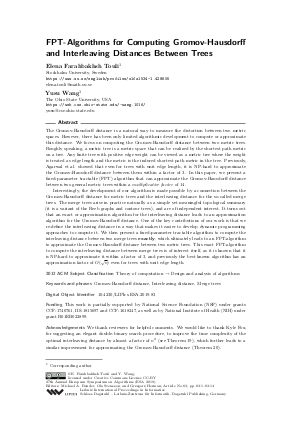@InProceedings{farahbakhshtouli_et_al:LIPIcs.ESA.2019.83,
author = {Farahbakhsh Touli, Elena and Wang, Yusu},
title = {{FPT-Algorithms for Computing Gromov-Hausdorff and Interleaving Distances Between Trees}},
booktitle = {27th Annual European Symposium on Algorithms (ESA 2019)},
pages = {83:1--83:14},
series = {Leibniz International Proceedings in Informatics (LIPIcs)},
ISBN = {978-3-95977-124-5},
ISSN = {1868-8969},
year = {2019},
volume = {144},
editor = {Bender, Michael A. and Svensson, Ola and Herman, Grzegorz},
publisher = {Schloss Dagstuhl -- Leibniz-Zentrum f{\"u}r Informatik},
address = {Dagstuhl, Germany},
URL = {https://drops.dagstuhl.de/entities/document/10.4230/LIPIcs.ESA.2019.83},
URN = {urn:nbn:de:0030-drops-112048},
doi = {10.4230/LIPIcs.ESA.2019.83},
annote = {Keywords: Gromov-Hausdorff distance, Interleaving distance, Merge trees}
}

 Creative Commons Attribution 3.0 Unported license
Creative Commons Attribution 3.0 Unported license




















